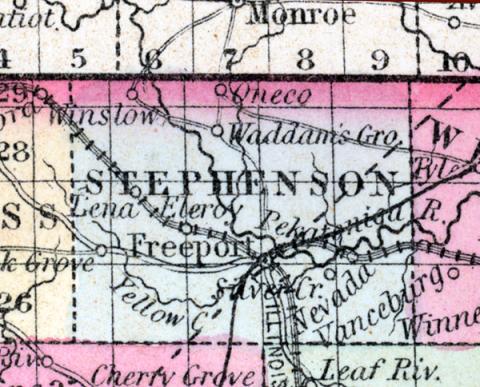FREEPORT, Is., c. h. Stephenson co. On Peekatonica River. 200 miles N. from Springfield. (Gazetteer of the United States of America, 1854)
FREEPORT. The city of Freeport stands on the southern bank of the Pecatonica river, a branch of Rock river, in a line directly west of Waukegan, 16 miles from the Wisconsin State line, 120 miles from Chicago, 102 miles from Racine, 67 miles from Dubuque, and 35 miles from Savanna, on the Mississippi river. It is one of the best business points in northern Illinois, west of Chicago; commanding the trade of a large and fertile section of country, comprising Stephenson county, and portions of Carroll, Ogle and Jo Daviess counties, Illinois and Green counties, Wisconsin — all a magnificent farming section. The amount of wheat annually shipped from Freeport is enormous. It is one of the greatest grain shipping stations in northern Illinois. It is this business which has given it the start it has obtained, and centered here other branches of business, all of which now aid to continue its growth and insure it a permanent prosperity. It has the advantage of excellent railroad connections — better than those of any other town in the northern tier of counties. It is situated at the junction of the Illinois Central railroad with the Galena and Chicago Union, the latter having its terminus here. The Racine and Mississippi railroad intersects the other roads at this point, affording a direct communication with Milwaukee and the north, and with central Iowa on the west. The gross amount of the railroad business done at Freeport during 1866 (before the Racine road was opened), was $330,677.27, as the books of the railroad companies show. This will give some idea of the position of Freeport as a railroad town.
In manufacturing interests, it is not as old as some other places, but its railroad facilities and nearness to the coal fields of Illinois, are advantages which are being appreciated. P. Manny & Co., have a large manufactory here, where they make the popular Pell Manny's Reaper and Self-Raker, one of the best machines in use, and the Manny Hay Press, and Sub Soil Plow. There is a large foundry connected with it, and a Sickle and Sickle Guard manufactory. The Sickle Guard is a new patent of Mr. Manny's, and bids fair to become of general use.
There is a Threshing Machine manufactory here, a Plow factory, an Iron foundry, a Brass foundry, a Sash, Boor and Blind and Furniture factory, a Planing mill, a steam Flouring mill, one or two Flouring and Saw mills driven by water power, a Soap and Candle factory, a Fanning mill establishment, a Corn mill, a Barrel factory, Marble Works, a machine shop, several Wagon factories, half a dozen lumber yards, etc.
The city is lighted with gas, the gas works having been built in 1836, and of a size calculated for the future growth of the place.
Among the new buildings recently erected here, is the Brewster House, one of the first hotel edifices in the west The main street of the city has been McAdamized the past season, at considerable expense. It is a valuable improvement.
There are nine church societies in the place, and eight houses of worship, as follows: Baptist, two Presbyterian, Episcopal, Methodist, German Reformed, Evangelical Methodist, and Roman Catholic. The Associate Presbyterians have no church edifice yet. There are several Masonic bodies, a lodge of Odd Fellows, two Fire Companies, a Young Men's Association, and a Young Men's Lyceum, which is in a flourishing condition.
The schools of Freeport are noted for their excellence. They are on what is termed the "graded" plan, being free to all, and afford all the advantages of an academical and collegiate education. There are seven schools now in operation, all under one general head, in which the scholars are graded according to their degree of advancement There are four newspapers published here, three English and one German. The Freeport Journal, published by C. K. Judson and C. W. McCluer. The Freeport Bullettin, by W. T. Giles and J. K. Scroggs. The Farmer and Advertiser, by J. Richards, and the Antzeiger, by Wm. Wagner. Population, 6,000. F. W. Brawley, Postmaster. (Hawes' Illinois State Gazetteer...,1859)

